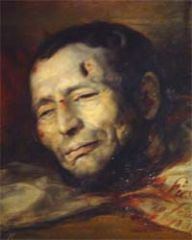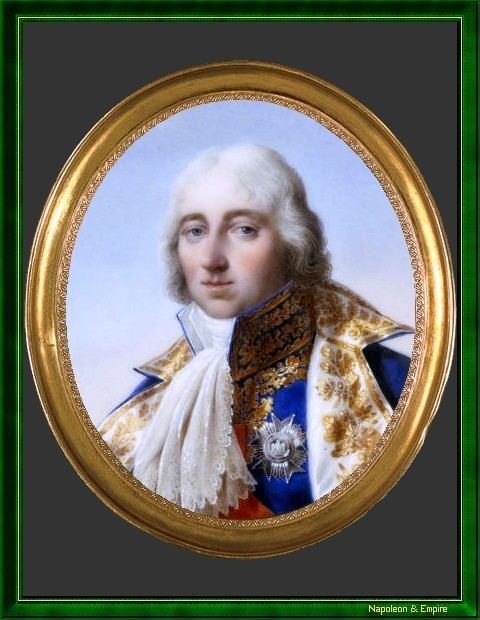Monarch Louis Philippe I Political party None | Name Edouard duc Role Duc de Trevise | |
 | ||
Preceded by Hugues-Bernard Maret, duc de Bassano Born 13 February 1768
Le Cateau-Cambresis ( 1768-02-13 ) Died 28 July 1835(1835-07-28) (aged 67)
Paris Assassinated July 28, 1835, Paris, France Succeeded by Claude Victor-Perrin, Duc de Belluno Children Napoleon Mortier de Trevise Grandchildren Edouard Napoleon Cesar Mortier de Trevise, Hippolyte Mortier de Trevise Similar People Auguste de Marmont, Jean‑Baptiste Bessieres, Michel Ney, Jean Lannes, Louis‑Nicolas Davout | ||
douard mortier duc de tr vise
Adolphe Édouard Casimir Joseph Mortier, 1st Duc de Trévise (13 February 1768 – 28 July 1835) was a French general and Marshal of France under Napoleon I. He was one of 18 people killed in 1835 during Giuseppe Marco Fieschi's assassination attempt on King Louis Philippe I.
Contents
- douard mortier duc de tr vise
- Biography
- Revolutionary and Napoleonic Wars
- Post war career
- Death
- Family
- References
Biography

Mortier was born at Le Cateau-Cambrésis on 13 February 1768, son of Charles Mortier (1730 – 1808) and wife Marie Anne Joseph Bonnaire (b. 1735), and entered the army as a sub-lieutenant in 1791.
Revolutionary and Napoleonic Wars

He served in the French Revolutionary Wars in the campaigns of 1792 and 1793 on the north-eastern frontier and in the Netherlands, and subsequently on the Meuse and the Rhine. Mortier was tasked by Hatry to negotiate the surrender of the Fortress of Mainz, which he completed successfully and then returned to Paris. In the war against the Second Coalition in 1799, he was promoted successively general of brigade and général de division. During the Second Battle of Zurich, he led a force of 8,000 in the attack from Dieticon on Zurich. His conduct of the French occupation of Hanover, bringing about the Convention of Artlenburg, led Napoleon to include Mortier in the first list of marshals created in 1804.
He commanded a corps of the Grande Armée in the Ulm campaign in which he distinguished himself. In the campaign of the middle Danube, which culminated in the Battle of Austerlitz, Napoleon placed him in command of a newly formed VIII. Corps, composed of divisions from the other Corps. Mortier over-extended his line of march on the north shore of the Danube and failed to heed Napoleon's advice to protect his north flank. A combined force of Russians and Austrians, under over-all command of Mikhail Kutuzov enticed Mortier to send Théodore Maxime Gazan's 2nd Division into a trap and French troops were caught in a valley between two Russian columns. They were rescued by the timely arrival of a second division, under command of Pierre Dupont de l'Étang's 1st Division, which covered a day's march in a half day. The Battle of Dürrenstein (11 November 1805) extended well into the night. Both sides claimed victory, the French lost more than a third of the participants, and Gazan's division experienced over 40 percent losses. The Austrians and Russians also had heavy losses—close to 16 percent. After Austerlitz, Napoleon dispersed the Corps and Gazan received the Legion of Honor, but Mortier was simply reassigned.
In 1806 Mortier was again in Hanover and north-western Germany. In 1807 he served with the Grande Armée in the Friedland campaign, in the siege of Stralsund, and in the siege of Kolberg.
In 1808, Napoleon created him duke of Treviso (Trévise in French) a duché grand-fief (a rare, but nominal, hereditary honor, extinguished in 1946) in his own Kingdom of Italy, and shortly after he commanded an army corps in Napoleon's campaign for the recapture of Madrid.
Mortier remained in Spain for two campaigns, winning the victory of Ocaña in November 1809. In 1812 and 1813 he commanded the Imperial Guard, and in the defensive campaign of 1814 he rendered brilliant services in command of rearguards and covering detachments. In 1815, after the flight of Bourbon king Louis XVIII of France, he rejoined Napoleon during the Cent Jours and was given command of the Imperial Guard, but at the opening of the Battle of Waterloo he was unable to continue due to severe sciatica.
Post-war career
After the second Bourbon Restoration he was for a time in disgrace, but in 1819 he was readmitted to the Chamber of Peers and in 1825 received the Order of the Holy Spirit, the kingdom's highest. In 1830–1831 he was Ambassador of France to Russia at St Petersburg, and in 1834–1835 minister of war and president of the council of ministers.
Death
On 28 July 1835, Mortier was one of those accompanying King Louis-Philippe of France to a review of the Paris National Guard, an annual event that commemorated the July Revolution that brought Louis-Phillipe to power in 1830. In the Boulevard du Temple the royal party was hit by a volley of gunfire from the upstairs window of a house. Eighteen were killed, including Mortier, and 22 injured. The King received a minor wound.
The weapon used was a home-made volley gun, constructed and fired by Giuseppe Marco Fieschi for the purpose of assassinating Louis-Philippe. Fieschi had fixed twenty-five musket barrels to a wooden frame, and arranged that they could be fired simultaneously. Four of the barrels burst when fired and Fieschi was badly wounded. He was quickly captured and later tried with two co-conspirators. The three went to the guillotine in February 1836.
Family
Mortier married Eve Anne Hymmès (Coblence, 19 August 1779 – Paris, 13 February 1855), by whom he had issue:
